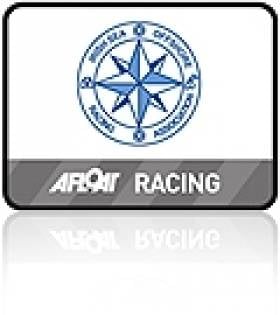Displaying items by tag: ISORA
Report on Race 4 – Pwllheli – Causeway - Bardsey – India Nt - Wicklow – 5th June 2010.
From an entry list of 28 sailing boats, 14 boats came to the line in Pwllheli for the 4th ISORA race – 75 miles to Wicklow. Due to tidal difficulties the race start time was brought forward to 07.15. The weather forecast was for light winds increasing to Force 3 or 4 and veering North West. However a reasonable wind of 8kts in Pwllheli, early in the morning convinced the Race Organiser to hold the planned course to Wicklow. The wind held well for the beat to Causeway and for the tight spinnaker reach towards Bardsey. “ Galileo” was first around Causeway followed by “Tsunami”.
As the fleet approached Bardsey the wind dropped to virtually nothing. “Tsunami” had just enough wind to creep around Bardsey first while the remainder of the fleet wrestled with the possibility of the tide pushing them through the sound and around the wrong side of Bardsey.The wind picked up from the West for “Tsunami” after the rounding Bardsey and a fast passage to Wicklow was expected. This was not to be as the wind died again and a heavy sea mist appeared. There was little or no wind for 3-4 hours. When eventually the mist lifted and the westerly wind appeared again, only four boats were visible – “Tsunami”, “Raging Bull”, “Just Enough” and “Lula Belle”.
The four boats continued across the Irish Sea, within sight of each other, with the wind shifting all the time and disappearing at times. At approximately 02.30 on Sunday morning “Raging Bull” rounded Nt India followed by “Tsunami” and “Just Enough”. “Lula Belle” could not be seen. The wind picked up again and soon there was 14kts of wind from the North West and the boats roared towards the Wicklow finish.
The wind had not finished playing its tricks. The usual “Wicklow Hole” had formed within one mile of the finish line and the boats ground to a halt as they arrived there. Very tricky sailing was required to manoeuvre in the light winds and the then strong south going tide to the finish.The first boat to cross the finish line was “Raging Bull” at 04:01, who only managed to take 2nd Overall and 1st in Class 1. It was followed closely by “Tsunami” who took 2nd in Class 1 and 3rd Overall. “Just Enough” appeared over the finish line at 04:28 to take the Overall Win and Class 2. “Lula Belle” continued to battle the fluky conditions and finished at 12:25 to take 4th Overall and 2nd Class 2.
There were no other finishers.
The next race is next weekend 13th June, a Sunday Day Race from Dun Laoghaire. It is hoped that some new boats will use this race as a “taster” for ISORA. An Après Sail get together is arranged in the NYC after the race.
Results and Entry form race five is attached.
Start Time Changes for ISORA Yacht Race
Possible tidal problems in Wales have forced Irish Sea Offshore Racing Association (ISORA) Commodore Peter Ryan to change the start of the fourth sailing race across the Irish Sea back to Wicklow to 07.15 next Saturday in Pwllheli. More on the afloat forum here including race entries.
Planning to do the Round Ireland Yacht Race this month?
Planning to do this year's Round Ireland Yacht Race? You could do a lot worse than listen in to how Galway's Aodhan Fitzgerald put together a team of friends to win the 2008 race. Also on Afloat.ie are navigation tips from tactician Brian Mathews. There is little over a fortnight to the race start in Wicklow. Notice of race here. Get your crew together now for the 16th circumnavigation!
More on the Round Ireland Yacht Race:
Round Ireland Yacht Race 2010 Review
Round Ireland Yacht Race, Ireland's top offshore fixture
A Round up of 80 stories on the 2010 Round Ireland Yacht RaceISORA Get Ready to Race from Pwllheli to Wicklow
Just three weeks before the Round Ireland sailing race kicks off in Wicklow ISORA is preparing to race there in June 5th's race from Pwllheli in North Wales. When most regattas and events this season have struggled to raise entries the ISORA season has been marked with a dramatic rise, taking the offshore fleet to over 20 boats. Entry list and more details for he fourth race (inlcuding eve of race BBQ steaks in Wales) are on the ISORA thread on the Afloat forum here.
From an entry list of 30 sailing boats, 19 boats came to the line in Holyhead for the 3rd ISORA race – 75 miles to Dun Laoghaire. The fleet, that was missing many of their “regulars” had four newcomers to ISORA - “Mojito”, Peter Dunlop, “Poppy of St. Helier”, John Roberts (another John Roberts), “Intuiition” and “One Life”, both of Sailing West Sailing School.
There were two significant predicted factors affecting the race – the extremely strong Spring Tides and a wind shift from northwest to southwest during the race. As forecast the wind was 12knots northwest at the start and immediately the fleet split into two halves. The main fleet headed south plugging the north going tide while a small bunch headed north using the strong tide.
The wind followed its forecast and backed south-west although the north part of the fleet were lifted onto Rockabill, the wind was stronger for the south fleet who arrived under spinnaker.
Despite this the entire fleet, closely bunched met again at Rockabill. “Tsunami”, Vincent Farrell, who was part of the north fleet, round first, followed closely by “Raging Bull” Matt Davis and “Intuition”, Sailing West Sailing School, both of whom were part of the south fleet. The strong tide had just turned to go north as the fleet rounded and made their way to Kish.
The wind, that had been very fickle at Rockabill increased to 20 knots shortly after the leaders rounded Rockabill and it was a beat to Kish. The wind had not finished its gyrations and the fleet experienced a huge wind shift off Lambay. This shift enabled those who had gone towards the coast to crack off and reach to Kish while those who stayed out fetched to the mark.
Despite this the leader order of rounding the Kish was the same as rounding of Rockabill. The new wind direction produced a beat from Kish to the finish with the wind reducing to 7 knots at the finish. The first boat to cross the finish line was “Tsunami”, who only managed to take 2nd in Class 1. It was followed closely by Matt Davis’s “Raging Bull” who won Class 1. “Intuition”,
Sailing West Sailing School, crossed the line 3rd to take 3rd in Class 1. Class 2 was won by “Poppy” followed by “Mojito” and “Just Enough”, Stephen Tudor.
Class 2 boats dominated the overall results with the same boats winning the overall positions.
As newcomers to ISORA, “Poppy” and “Mojito” have really made a huge impact in their inaugural race and ISORA's hope is their presence can be repeated on the ISORA start line in the future. The next race is next weekend 5th June from Pwllheli to Wicklow. It is another 75- mile race.
ISORA Fleet Head for Holyhead
After two successful outings for the ISORA sailing fleet, now at 20 boats, next weekend's fixture starts on the far side of the Irish Sea at Holyhead. Commodore Peter Ryan has posted the entries for the race back to Dun Laoghaire (click here). He is encouraging skippers to make the delivery trip over to Wales in time for Saturday.
Raging Bull Wins Blustery ISORA Race
Matt Davis sailing Raging Bull (a Sigma 400) took first place overall in the second race of the ISORA series sailed in blustery conditions on Saturday. ISORA newcomer Ken Grant and “Tigh Soluis” took second overall and first in Class two. “Galileo” took third Overall and second in Class 1. “Tsunami” took third in Class one while “Legally Blonde” took second Class two and “Lula Belle” took third in class two.
From an entry list of 26 boats, 20 boats came to the line in Dun Laoghaire for the 2nd ISORA race and the first in conjunction with the Royal Alfred Yacht Club and their Lee Overlay Offshore Series. The fleet had two newcomers to ISORA- “Rollercoaster” and “Tigh Solus”.
The wind remained constant for the entire race North- East, 20-25 knots. The tide also was ideal with a south going tide for the leg to Arklow North, turning as the fleet rounded to go north to Dun Laoghaire. The wind and tide gave a fast invigorating race. Even the sun shone. It was perfect offshore conditions.
With a beam reach to the Muglins and a reach down to North Arklow the fleet kept very tight. There was even crowding for some boats rounding North Arklow. The close proximity of the boats kept all the crew driving their boats for the duration of the race.
The leg to the Muglins, before turning into Dublin Bay for the finish at the Harbour lighthouses, was a long leg- short leg beat. Due to the north-easterly that had been blowing for some days the seas were rough and extreme care had to be taken to steer the boats around the breakers.
The first boat to cross the finish line was “Galileo”, Tennyson, Lemass and Kelliher. It was followed closely by Matt Davis’s fast Sigma 400 “Raging Bull” with “Tsunami”, Vincent Farrell close behind. The entire fleet finished the 50 mile course within two hours of “Galileo”.
The next race is next weekend 15th May from Holyhead to Dun Laoghaire. It is a 75 mile race. This is also the feeder race to the ICRA Championships being run in the Royal St. George Yacht Club. Results attached.
Breezy Start Forecast for ISORA Race to Arklow
ISORA has released the 25–boat entry list for what's forecast to be a breezy start to tomorrow's second ISORA race from Dun Laoghaire to Arklow and back. Any boats visiting Dun Laoghaire are welcome to use the facilities of the National YC, says ISORA and NYC Commodore Peter Ryan. The race briefing will be held at Dun Laoghaire marina tomorrow morning at 0845.
New Trophy for Offshore Race from Cork to Dublin
A new sailing trophy will be awarded to the winning yacht in a new offshore race from Cork Harbour to Dublin as part of the build up to the Irish Cruiser Racer Nationals to be held on Dublin Bay from May 21-23.
The feeder Race will take place from Royal Cork in Crosshaven on Friday 14th May. Commodore's Cup team boats will use the passage as part of their offshore practice.The Race also can be used as a qualifier for next month's Round Ireland Race and it will also accomodate double handed entries.
111 boats have already entered the Liebherr Nationals from 21st to 23rd May in the Royal St George Yacht Club in Dun Laoghaire. Event organisation is in full swing to ensure a quality event both aflaot and ashore, says ICRA Commodore Barry Rose.
Entry forms and sailing Instructions will be available at the Royal Cork Yacht Club. Interested boats are requested to inform ICRA of their intention to compete. The ICRA perpetual offshore trophy will presented to the winning yacht.
After a record turnout for its first race of the season to Holyhead a week ago ISORA Commodore Peter Ryan has appealed for a similar effort for next weekends race from Dun Laoghaire to Arklow and back. This ISORA race will be run with the Lee Overlay/Royal Alfred Yacht Club 2010 Offshore Series race using the same start, course and finish. Boats may enter both series. Boats entered in the ISORA series only shall not be scored in the Lee Overlay/RAYC series nor are eligible for prizes in that series.
TIME OF START FOR ALL CLASSES
09.55 Warning signal - Class flags (Numerals 1 & 2) hoisted
09.56 Preparatory Signal - Blue Peter hoisted
09.59 Blue Peter down
10.00 Start – Class flags down
The start may be broadcast on VHF Channel 72.
STARTING LINE
The start line shall be located in Scotsman’s Bay in the vicinity of DBSC ‘Pier’ mark between the mast of a committee boat flying the RAYC burgee and a start mark at the port end. A boat shall not start later than 15 minutes after her Starting signal. Prior to the start of each race boats are requested to obtain acknowledgement from the Race Committee.
THE COURSE
1. STARTING LINE
2. Muglins to starboard
3. Arklow North to Port
4. Muglins to port
5. FINISH LINE
The Course will be confirmed at a briefing at 08.45 at the Marina offices and afloat to the competitors on channel 72 before the start.
SHORTENED RACES
The race may be shortened at a mark and will be signalled by calling the fleet on Ch 72. If the fleet doesn’t finish a race or shortened race, the race committee may take the result from the mark at which one third or more of the fleet round from the direction last mark.


























